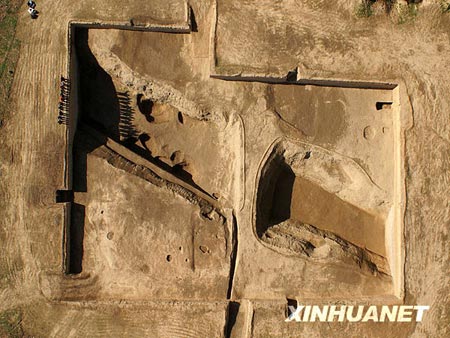 |
|
Photo taken on Nov. 19, 2008 shows an overhead view of part of the Yangguanzhai ruin in northwest China's Shaanxi Province. [Xinhua] |
A group of man-made cave houses dating back 5,500 years ranked top among the 10 most significant archaeological discoveries in China in 2008, the State Administration of Cultural Heritage (SACH) announced on Tuesday.
Other discoveries included a Bronze-Age graveyard in northwest China's Gansu Province, a tomb that proves the existence of a kingdom during the Spring and Autumn Period (770-476 BC), and a "shopping district" of the Song Dynasty (960-1279) in southwest China's Chengdu City.
"Every discovery, chosen from 25 nominated projects, is of great and special significance in archaeological studies," said Xu Pingfang, a leading archaeologist with the Institute of Archaeology under the Chinese Academy of Social Sciences.
The Yangguanzhai ruin, in northwest China's Shaanxi Province, consists of 17 cave houses on a cliff and adjacent pottery kilns near Gaoling county, 20 km away from the provincial capital Xi'an.
Scientists believe the caves, built between 3,500 to 3,000 BC, were the earliest man-made cave homes in China, and belonged to a late Neolithic culture named Yangshao.
Yangshao culture originated on the middle reaches of the Yellow River and was considered a main ancestor of Chinese civilization.
Archaeologists also found pottery kilns and caves to store pottery beside the houses in Yangguangzhai, as well as pottery items, fragments and tools. They believed the caves were homes to families of pottery makers.
In Lintan County, Gansu, archaeologists excavated more than 340tombs at a graveyard near the Tao River and unearthed many pottery items, which were believed to provide new clues to the study of 4,000-year-old Qijia culture.
The excavation of the Shuangdun tomb in Bengbu City, central China's Anhui Province, provided strong evidence for the existenceof the Zhongli Kingdom during the Spring and Autumn Period, thanks to enormous discoveries of bronze and pottery items.
The site of an ancient city in the center of Chengdu, capital of Sichuan Province, triggered curiosity among researchers and the public about possible boom of the city during the Tang (681-907) and Song dynasties.
The ongoing excavation found the city had already developed advanced street and sewage systems in its commercial center.
The site was found accidentally when a real estate project was constructed in the center of Chengdu.
"It is very rare in China that an urban construction contributed to such a big archaeological discovery," said Tong Mingkang, deputy director of the SACH.
This was the 19th consecutive year that the SACH invited renowned archaeologists to choose top 10 archaeological discoveries of the year.
(Xinhua News Agency April 1, 2009)